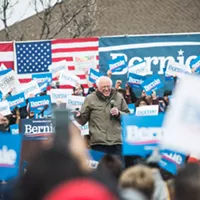Buzz Blog
Gurl, Bye?
Tulsi Gabbard addresses alleged media blackout and other ‘big challenges’ during SLC stop.

- Rich Kane
Hawaii congresswoman Tulsi Gabbard made four campaign stops in Utah over the weekend as part of her run to become the Democratic nominee for president, a bid that’s become even more of a longshot than it already was after poor showings in Iowa (where she earned 0%), the New Hampshire primary (3.3%, enough for seventh place, but not enough to earn any delegates) and Nevada (0.1%).
But numbers be damned! There she was Friday night at Pierpont Place in downtown Salt Lake City, in front of a crowd of about 200, far less than the turnouts at local rallies by her rivals Pete Buttigieg and Michael Bloomberg earlier in the week.
It was easy to ask Gabbard about her poor showings and why she hasn’t dropped out yet. During a quickie pre-event press conference, there was myself and two other journalists—and they were both photographers.
“Only two states have voted,” a wildly optimistic Gabbard told City Weekly. “We have some big challenges. There has been an almost total corporate media blackout of my campaign, some even refusing to mention I’m still in the race, even though I’m the only person of color remaining and the first female combat veteran ever to run for president. They try to smear my candidacy. All these different obstacles make it harder for me to get my message out in front of people, but the more we do that, the more support continues to grow.”
Zero-point-one in Nevada probably isn’t the kind of growth Gabbard wants. Her blame-the-media excuse avoids the fact that, sorry Tulsi, they’re just not that into you. At this stage of any presidential campaign, the front-runners will naturally garner most of the news coverage. She no longer is qualifying for any of the debates, and she’s mostly gotten attention lately for voting “present” on Donald Trump’s impeachment and filing a $50 million defamation lawsuit against Hillary Clinton for labeling her a “Russian asset.”
Clinton’s point with lobbing that grenade—she never mentioned Gabbard by name, but it was clear who she was referring to—was that Russia is once again supporting wedge candidates like Gabbard through manipulative social media campaigns similar to ones that helped elect Trump in 2016.

- Rich Kane
“I certainly think she’s served the purpose of tearing the Democratic Party apart,” says Anthony Pignataro, a former editor of MauiTime Weekly, who has covered Gabbard extensively.
“She’s definitely unhappy with the state of the party and has long been more critical of Democrats than Republicans,” Pignataro tells City Weekly. “She doesn’t help herself either when she has very embarrassing things happen, like when [neo-Nazi and white supremacist] Richard Spencer and [former Trump strategist] Steve Bannon endorsed her, and her response wasn’t as angry as it probably should have been.”
Gabbard wants to appeal to a center in a political world that’s solidly, perhaps permanently polarized. That’s who came out to hear her Friday. At one point, Gabbard asked for a show of hands to find out who was a Democrat, a Republican or Independent. The indie palms far outnumbered ones of the two main parties.
She spoke of dismantling the military-industrial complex and moving the $4 billion being spent each month in Afghanistan to pay for education, infrastructure and other domestic programs. She talked about health care and getting the greed out of Big Pharma and fixing immigration and beating Trump, like every other candidate.
“She’s incredibly ambitious,” Pignataro says. “She wants to be president and if she doesn’t make it this time, she’ll run again. She’s young. I think she’ll stay in as long as she can, maybe angle for a cabinet post if a Democrat wins. Or even angling to be the vice president on a Sanders ticket.”
But as much as Gabbard wants to believe the media is her problem, her biggest obstacle is herself. She has about as much stage presence and charisma as Adam Driver on strong sedatives. When one of her supporters at Pierpont asked Gabbard, how can she still hold true to the party considering how she’s been treated by its leaders, she responded, “By running for president, being the Democratic nominee and leading the Democratic Party and bringing about those changes.”
That’s it, that was her answer.
